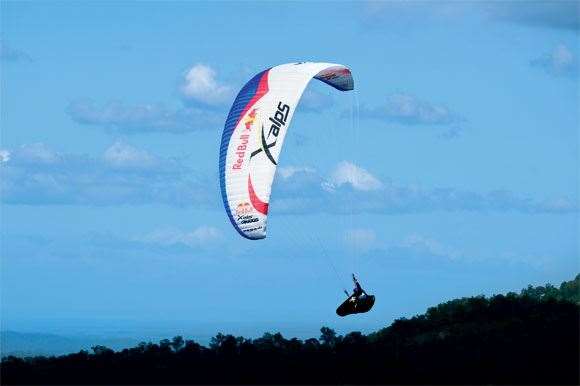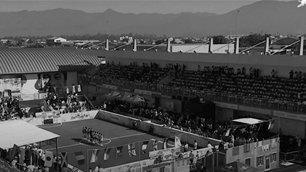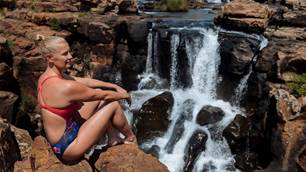Like with most sporting events sponsored by Red Bull, the X-Alps is one hell of a race.
 Photos by Red Bull
Photos by Red Bull
Storm-chasing
“I’ve had a couple of nasty scares in the X-Alps. One time I walked around the bottom of the Marmolada [a 3343m-high mountain in northern Italy], found a good take-off spot, and I’d just come up over a pass when I saw this huge thunderstorm coming. Now, this is not good news. I’m at 2500m above the valley floor and I’m thinking, ‘Oh God, there’s no way I’m making it down to the valley floor, there’s no real protection up here.’ So I thought about it and said, ‘Nope, I’m going to fly off.’ The storm had been sitting stationary in the valley for some time, so I thought I might be able to avoid it. But as soon as I took off it started coming towards me, so I had to make a bee-line the other way, get downwind, and outrun the thing. I remember looking behind me at one stage and I could see lightning bolts hitting the ground, torrential rain ... All the hot air in the valley was lifting, so it was pushing me up. I had to make radical manoeuvres to get back to ground, but the lower I got, the heavier the rain became and I was worried ‒ dropping into this narrow valley ‒ that there might be big gust fronts forming. I won’t say I was terrified ... but for half an hour I was pretty worried. I kept looking up at my wing thinking, ‘How much rain can this thing take?’”
What training?
“The average person would probably take two years of paragliding before they start thermalling; before they start cross-country flying. From that point, there’s not a lot of training. It’s mainly
about talking to people, getting to know all this mental stuff, understanding the information around you. Your skills get to a certain level and after that it’s all about the mental side of things. So my training was just doing as many competitions as I could. I just love the atmosphere; I love the adventure-type people who come to these things.“I once met Novak Thompson in Queensland. Now, Novak’s probably Australia’s best adventure racer. He’s incredible – runs and bikes amazing distances on an hour-and-a-half’s sleep a day. When I met Novak, I asked him how he trains and he told me that his training is his racing. He barely ever trained. Races were enough for him. He told me, ‘Don’t train any more than two or three hours a day, Lloyd. That’s all you need to do. In this sort of racing it’s more about who you are. Some people never give up, others just crumble.’ It’s a good point ‒ this type of racing is more about mental fitness than anything else.”
Going long
“My first X-Alps took me 17 days. During that race we didn’t have very good weather, so most of the time was spent on the ground. And I did pretty well there – I always made up time when I was on the ground running. I wasn’t fast on the ground, but I could go long distances, keep moving for long hours. So I was doing well when the weather was bad. I was averaging about 80km a day on the ground, plus whatever I was doing in the air. During that race I didn’t have any schedule as to when I’d sleep ‒ I just slept when I felt like it. I waited until I was totally exhausted and that was counter-productive because I over-exhausted myself and that affected my flying. During that race I was sleeping around three hours a day, broken up into a couple of blocks. A couple of days I might have slept six hours.“In my second race I was doing very well. On the second day I went from the back of the field to third place ‒ and that was purely because I made good decisions when I was flying. I got a good sleep that night and I had a good route mapped out the next day. Everything was going to plan ... Then I sprained my ankle. Just walking along – simplest thing! I kept going but that night my ankle was completely blown up. I slept a couple of hours that night, then woke and found I couldn’t even put weight on it. So I stumbled on. For the next five days I was limping with this completely swollen leg. On the seventh day I had to quit. I was still doing pretty well, averaging almost 80km a day, but the ankle started affecting my flying. I was so tired and in so much pain that I wasn’t flying well. Them’s the breaks ... ”
Strategy
“In my first X-Alps race everyone thought the favourite ‒ a Swiss bloke called Alex Hofer – was a sure thing. But at the start of the race this Polish bloke we all called ‘The Machine’ just started running. And he just ran the whole race. It was only on a really good day that he’d bother flying. The rest of the time he just ran. Now, everyone had always assumed you can’t win this race on the ground. But this Polish bloke was leading the race until the final day. It was only in the last four hours that Hofer flew this incredible 200km route and overtook him. It just blew everyone away that this bloke could run so fast, for so long. Hofer was calculating, well prepared, took the best routes - everyone had always assumed this was the only way to win the race; everyone had assumed it was all about strategy. But The Machine proved pure fitness is still very important ...
“In last year’s X-Alps, however, Christian Maurer emerged. This bloke is a freak pilot, the Tiger Woods of paragliding, and he came along with this supporter who’d spent six months planning every single possible route. This bloke had the entire Alps sectioned off. Every time Maurer arrived at a point, he had five possible routes to choose from. He had the works. All he had to worry about was flying. And, of course, he won by a mile. So he just showed what planning can achieve.“So it gives you an interesting perspective: over those two years, The Machine showed that you’ve got to be fit; Maurer showed that, yes, you’ve got to be fit, but that you’ve also got
to be strategic.”
‒ Aaron Scott
Related Articles

Aussie baller's Neymar encounter and Brazil skillz sojourn

Iffland jumps into South Africa













